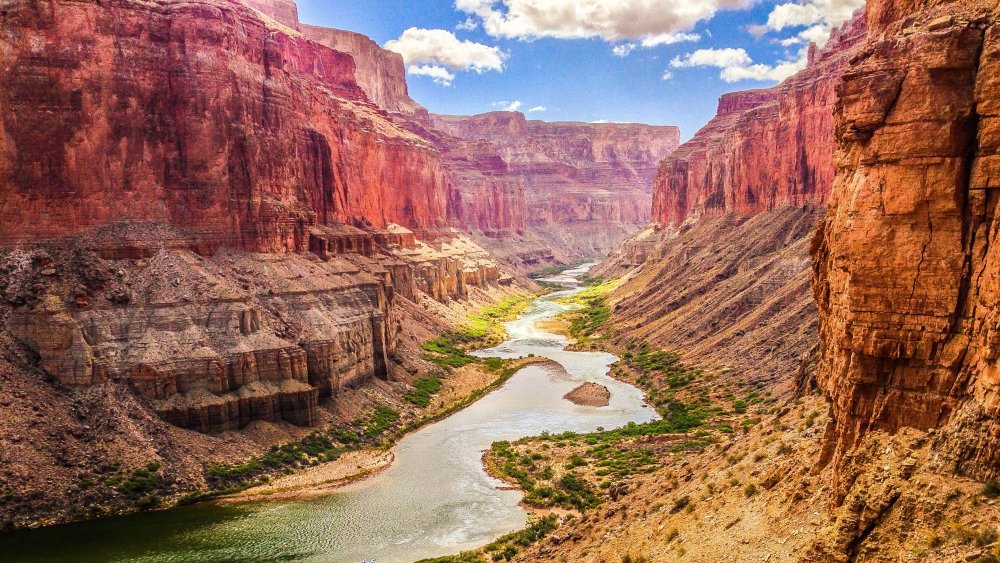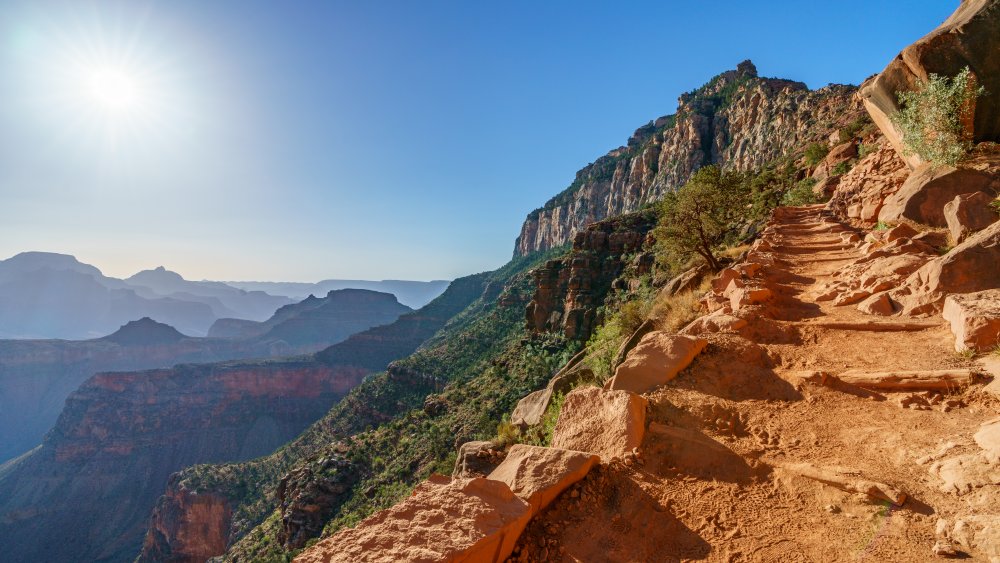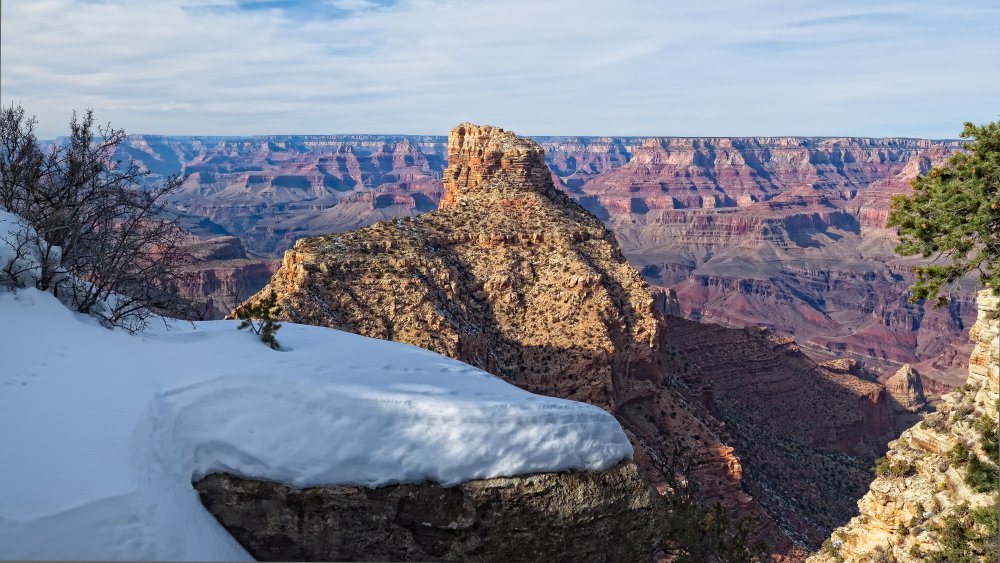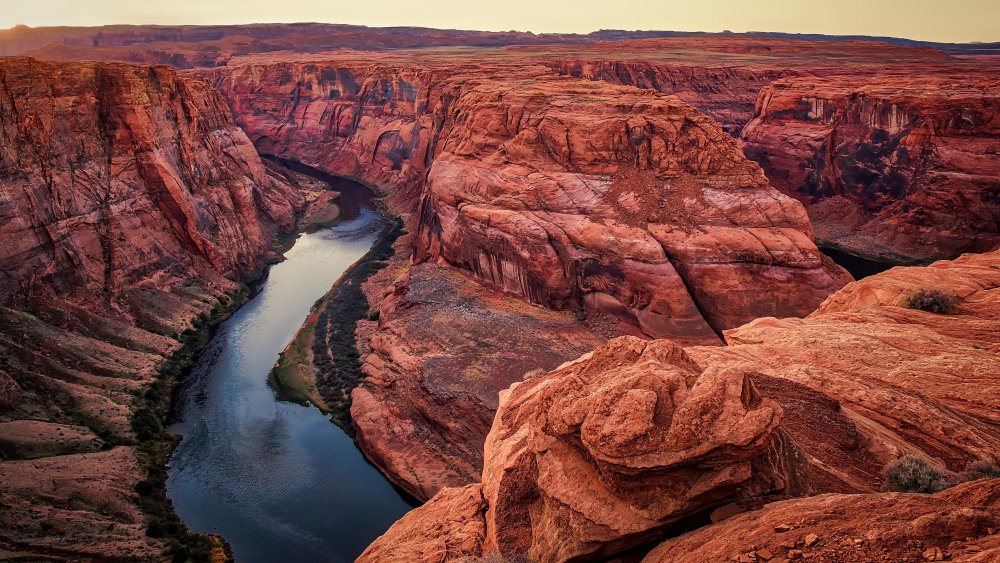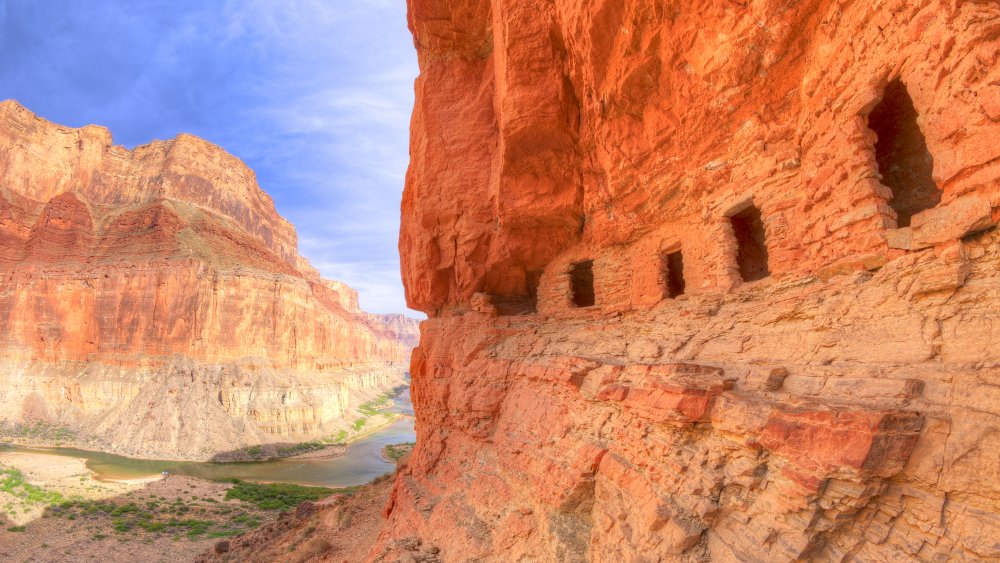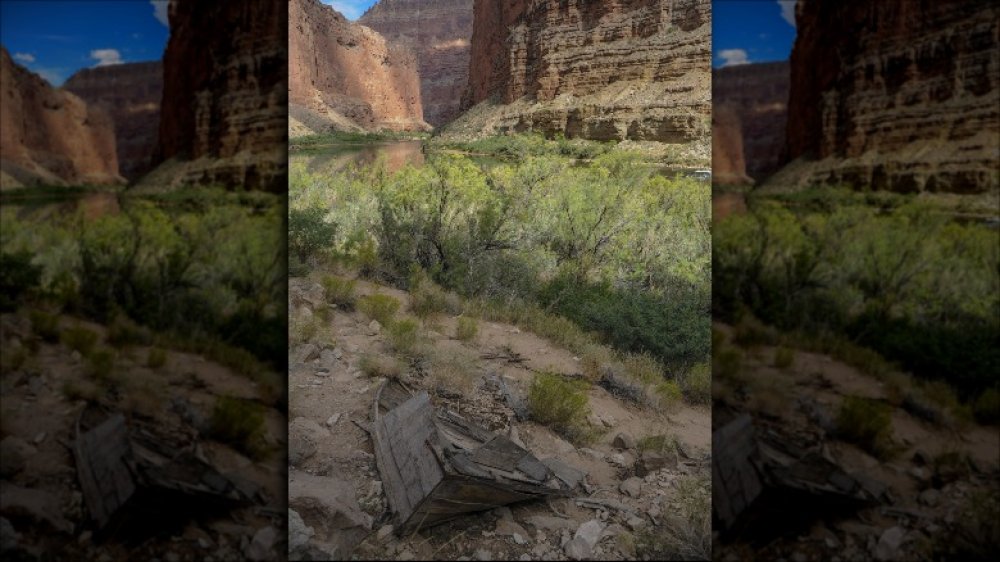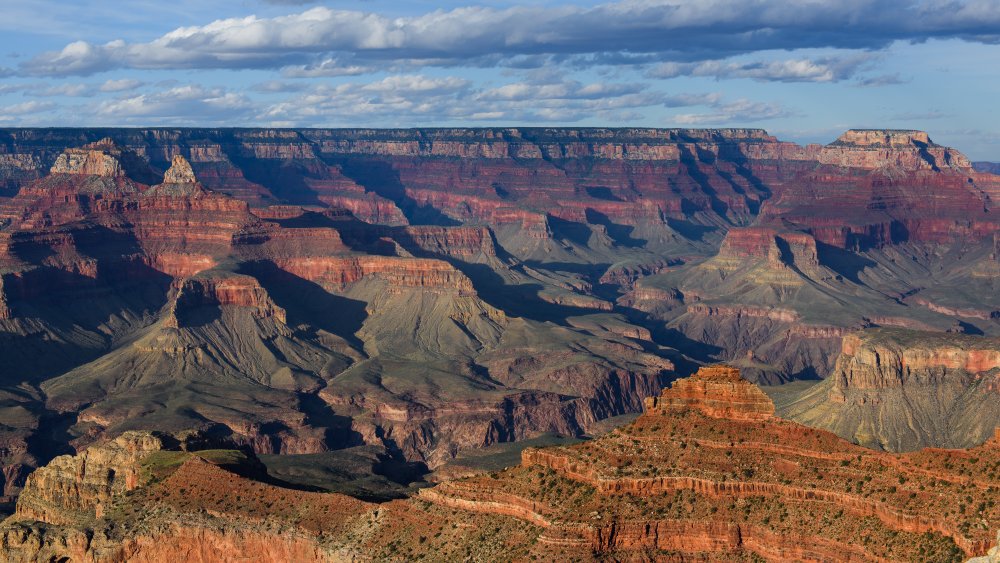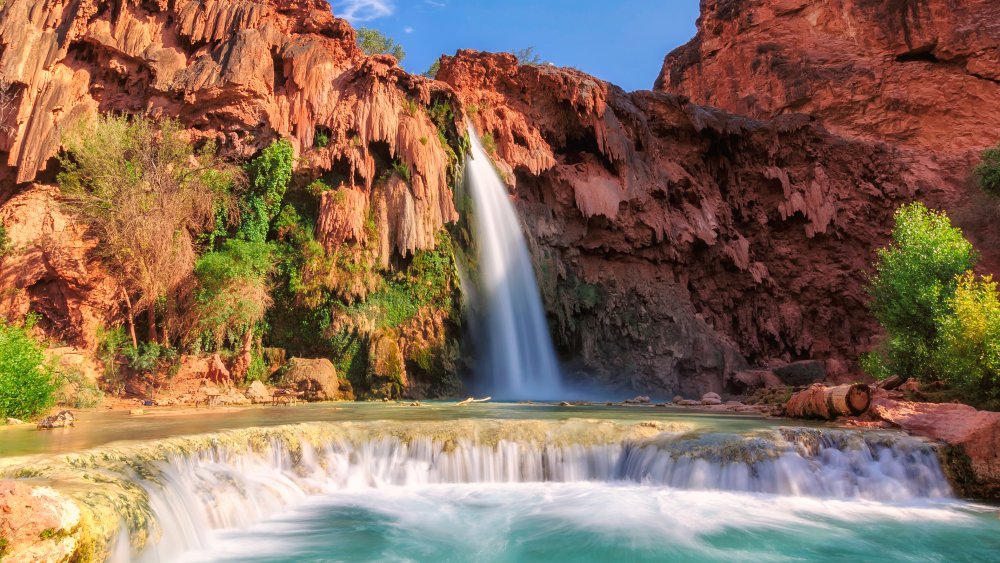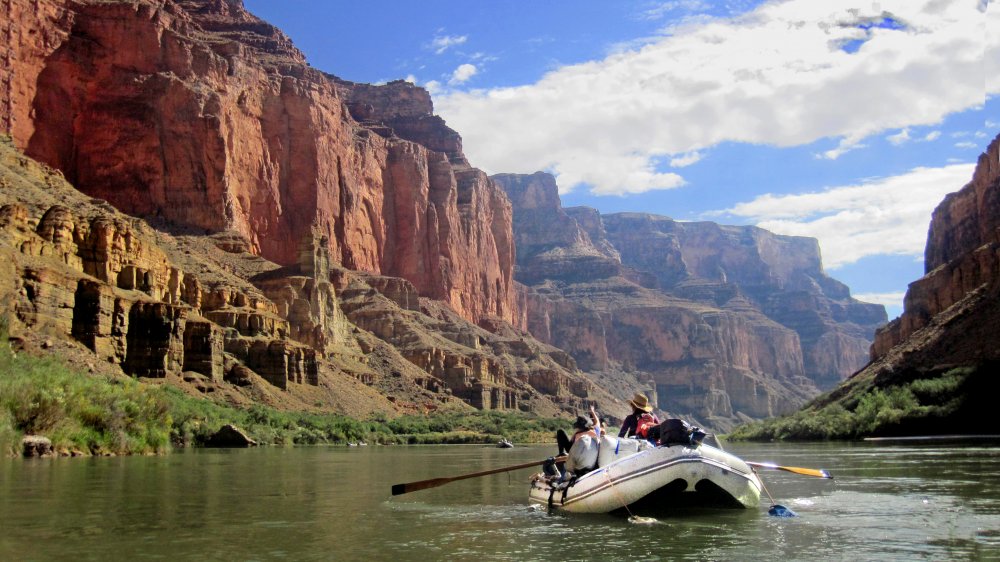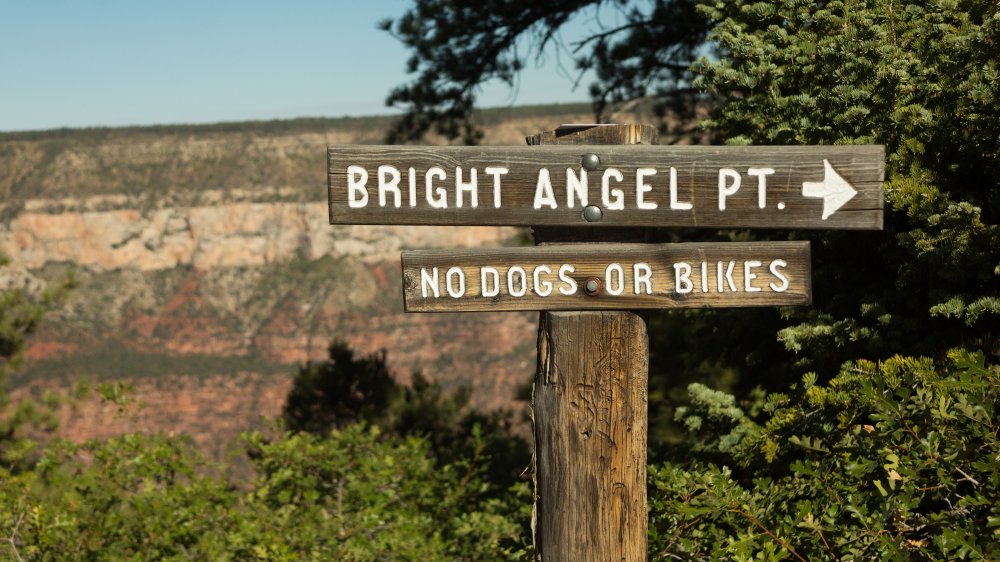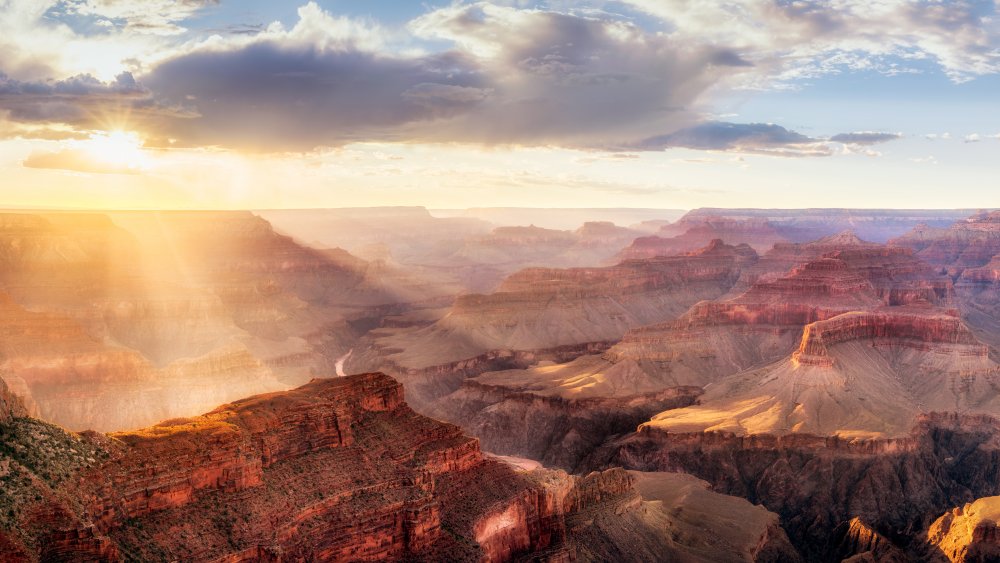People Who Mysteriously Vanished In The Grand Canyon
America is a place of breathtakingly beautiful natural wonders, from the forests and mountains of the Northeast to the beaches of the Southeast coast, to the snowy landscapes of Alaska, and all the way to the deserts of the Southwest. And nowhere is that beauty more evident than at the Grand Canyon, a stunning vista where it seems that you can see forever... and where, at the same time, it seems like you're looking into a painting.
It's almost mind-numbing just how big it is. According to the U.S. Department of the Interior, the Grand Canyon National Park is actually bigger than the entire state of Rhode Island. It's so big that it influences weather patterns, took more than six million years to form, and has more than 1,000 caves in it — there are so many caves, in fact, that no one's entirely sure just how many there actually are.
It's estimated that somewhere around 5.9 million people visit the canyon each year, and, sometimes, bad things happen. My Grand Canyon Park estimates that the chances of dying in the park are 1 in 400,000, and occasionally, people just disappear. Here are a few cases of people who have mysteriously vanished in the Grand Canyon.
Taking the easy route in the Grand Canyon isn't always the best
On Aug. 30, 1869, John Wesley Powell and his expedition did something awesome: they finished their run down the Colorado River and through the Grand Canyon. There hadn't been many people who thought they could do it, says VT Digger, and along the way, they were reported dead an impressive three times. Sadly, not everyone made it home.
Among Powell's team were a pair of half-brothers from Vermont, Seneca and Oramel Howland. On day 96 of the grueling trip, Oramel tried to convince Powell to give up. Otherwise, they — along with another expedition member named Bill Dunn — were hiking out of the canyon on their own. Powell debated but ultimately refused, and the three men walked into the wilderness and were never seen again.
Powell later tried to find out what had happened to the three men, and it wasn't long before he heard rumors they'd been killed by a group of Shivwit Indians. The next year, that was seemingly confirmed by a Mormon interpreter who translated for Powell: the Shivwit had mistaken them for prospectors who had attacked one of their own and killed them in retaliation.
But that might not be the whole story. Historians now suspect that the interpreter was lying and that the men had actually been killed by a group of Mormons who thought they were lawmen, coming after them in the wake of the Mormon massacre of 120 members of a California-bound wagon train.
Mysterious disappearance at the Grand Canyon? There's a little more to it...
In 1993, Robert and Donna Spangler headed to the Grand Canyon. While they were there, Donna fell. Robert later said that he had looked away to adjust his camera and when he looked back, she'd disappeared over the edge. Her body was recovered from 200 feet over the rim, and that was, seemingly, that.
The Los Angeles Times says not everyone believed it was an accident, including Donna's relatives. They said she was terrified of heights, and whatever happened there, it hadn't been voluntary. Now, fast forward to the year 2000 and Robert's diagnosis of brain and lung cancer. Thinking that he might be willing to talk, law enforcement paid him another visit.
Robert Spangler confessed that yes, he had pushed her... and he confessed even more than that (via ABC News). He also admitted that he had executed his first wife, Nancy, just a few days before Christmas of 1978 — and just before killing their 15-year-old daughter and 17-year-old son. Why? He wanted to be with his new girlfriend. Those deaths were ruled a murder-homicide, and his marriage to the girlfriend in question ended in divorce. He had married Donna after that and admitted that he'd pushed her because he was unhappy in that marriage.
In 2001, the AP reported that he had been sentenced to life in prison, and his cancer diagnosis was terminal.
Vanished into the thin air of the Grand Canyon
Floyd Roberts III went for a hike in the Grand Canyon on June 17, 2016. With him were his friend Ned Bryant and Ned's daughter, Madeleine. According to Strange Outdoors, they were the last people to see Roberts... and what happened was definitely strange.
Roberts was a one-time NASA employee, computer programming teacher, and experienced hiker who had been to the Grand Canyon before — so, when they reached a hill during the course of their planned nine-day hike, no one gave it a second thought when they split up. The Bryants went over the hill and Roberts went around, with the idea that they'd meet on the other side.
Roberts never made it, and when the Bryants backtracked, they could find no sign of him. After camping for the night, they hiked to an area where they had cell phone reception and called in a missing person alert that kicked off a six-day search involving seven ground teams, dogs, and National Park Service helicopters. They covered an area of ten square miles, and the only trace they found were footprints — but couldn't confirm they belonged to Roberts. He has yet to be found.
What happened in the Grand Canyon in those two weeks?
Not all mysterious disappearances have an unhappy ending, and occasionally, the news is good.
Martin Edward O'Connor spent the last days of 2019 at the Yavapai Lodge. According to The Washington Post, he was last seen there on December 22, after having arrived on December 17. Not long after, he was reported missing. He was traveling alone, and anyone who saw him was told to get in touch with the National Park Service.
Those sorts of stories tend not to end well, especially in the middle of the winter. Conditions were difficult, and it had started to snow during the days he was missing.
Miraculously, the park service got a tip that some hikers had spotted him on the New Hance Trail, one of the least maintained and most difficult trails in the canyon. The tip came in late on Wednesday, and when a helicopter was sent out on Thursday, he was found — with "limited resources," said park officials (via NBC News), but alive and well. The rescue team said "they were amazed at how well he was doing," and what exactly happened in the 11 days he was missing remains unknown.
Missing in the Grand Canyon? Or was there more to it?
The idea, says the Los Angeles Times, was that newlyweds Glen and Bessie Hyde were going to go on a grand adventure down the Grand Canyon, then earn their living not as bean farmers, but on the lecture circuit, talking about their record-breaking trip. They set off on Oct. 20, 1928, stopped at Grand Canyon Village to restock their supplies, and were last seen on November 18. Their boat was found a few weeks later, still afloat and still loaded. Those who had seen them previously said that Bessie seemed hesitant — she clearly didn't want to be there.
The dynamics of the relationship are pure speculation, but here's where the story takes a turn. Glen and Bessie were declared missing in 1928, and years later, another party was taking a trip down the same route when they came across a woman traveling alone. They asked her to join them, and she did. The Grand Canyon Visitor Center says that it was one night over a campfire that their guide started telling the story of Glen and Bessie, and that's when she said that she was Bessie. She claimed she killed Glen during a fight and wandered off to start a new life as Georgie Clark.
If that was all there was to it, it would be questionable. But after Clark's death, a search of her belongings turned up a birth certificate that identified her as Bessie DeRoss... and a marriage certificate for Glen and Bessie Hyde.
An ancient people of the Grand Canyon: did they simply move along?
The term "Anasazi" means two very different things in Navajo: according to the Grand Canyon Visitor Center, it means both "Ancient Ones" and "Ancient Enemies." They also say that it was a group of hunter-gatherers who truly started to flourish around 2,000 years ago and settled into the Grand Canyon, where they became skilled basket weavers, artists, and potters.
Then, they vanished, and no one is entirely sure what happened to them.
The Smithsonian puts the development of the Anasazi culture as early as 1500 B.C. and says that it was around 1250 that they started building defensive structures and moving their settlements high up into caves along the cliff faces. At the end of the 13th century, they fled — some abandoned old settlements, some left behind buildings newly constructed and half finished.
There's been a few theories, with the longest-running one suggesting there was a cataclysmic drought that forced them to move elsewhere. But some historians aren't satisfied with that: they had weathered droughts before. Others suggest an outside threat, but there has never been any evidence found of other peoples. Now, there's another theory gaining traction: the Anasazi were split into alliances, attacking tribes and families of their own, slaughtering others wholesale, and executing those who didn't agree. It would certainly explain the fortifications and the mass disappearances: those who didn't die, fled persecution.
Die doing what you love
Some people seem to be plucked straight out of an adventure novel, and Bert Loper was one of those guys. In 1920, he was a lead boatman on a survey mission along the area of the planned Hoover Dam, and according to The Paris News (via Find A Grave), he spent most of his life as a river runner.
And he didn't let age get in the way, either. In 1939, the 70-year-old Loper boated a 250-mile stretch of the Upper Colorado, and for his 80th birthday, he planned another trip. Only this time, it ended in tragedy. On July 8, 1949, his boat capsized for only the third time in his 56 years on the river. Loper vanished beneath the foaming waters.
A search party was immediately sent out, and they did find his boat — which they dragged ashore and left there (pictured). Loper's wife returned the following year to try to find out just what had happened. She was unsuccessful, and the year after that, she returned again to the site where Loper's boat still sat. There, she built a memorial from canyon marble and left a bronze plaque that read, "Bert Loper, Born July 31, 1869, lost July 8, 1949. The Grand Old Man of the Colorado River, I belong to the wondrous West and the West belongs to me."
His remains weren't recovered until 1975 — 26 years later. He was ultimately buried beside his wife in Salt Lake City.
Some people want to stay missing in the Grand Canyon
On May 12, 1992, Danny Ray Horning donned a "doctor's smock," strolled out of the Arizona State Prison, and disappeared. The New York Times described Horning as an Army veteran with extensive training in survival and reconnaissance, which went a long way in explaining how he was able to evade authorities for such a long time.
Horning was already serving four life terms for bank robbery — and looking at extradition for a murder case — when he escaped, fleeing from police in a series of stolen vehicles and leaving behind notes that demanded the release of his brother, who was serving a 29-year prison sentence. During his bizarre plan to kidnap a family and ransom them for $1 million and his brother's freedom, he kidnapped an Arizona couple and forced them to drive him to the place he spent much of his time on the run: the Grand Canyon. According to AP, he left two other kidnapping victims tied to a tree near the Grand Canyon National Park and headed off on foot to evade capture.
Horning ended up leading law enforcement on a wild goose chase that lasted almost eight weeks and involved more than 400 agents from the FBI, Border Patrol, and National Park Service. He was finally caught when he broke into a home in Grand Canyon Village to get a drink. The homeowner spotted him and called police, who found him sleeping on a neighbor's deck.
A birthday gift to the Grand Canyon turned deadly
In 2006, Tomomi Hanamure turned 34 years old. For her birthday, she had decided to do something epic: she left her home in Japan and went on a trip that included a visit to Havasu Falls on the Havasupai Indian Reservation. She had been staying in a lodge as she explored the area, and on May 9 — when the cleaning lady found she hadn't been back to her room — they kicked off a search for a missing hiker.
Her disappearance was brief: she was found the next day, floating in the Havasu Creek. She had been stabbed 29 times.
What had happened in the time she had been missing? After a months-long investigation, things seemed to be wrapped up. An 18-year-old Havasupai man named Randy Redtail Wescogame was charged with her murder. The motive was theft — he was looking for cash to fuel his drug habit, investigators said (via SNewsNet) — and she was in the wrong place at the wrong time.
That's not entirely the end of the story. Investigative journalist Annette McGivney wanted to learn more about everyone involved, and Wescogame's accounts of the abuse he suffered at the hands of his father brought back McGivney's own memories of childhood abuse. The consequences of a traumatic childhood laid bare, McGivney decided to found a non-profit called The Healing Lands Project, which partners with the Family Violence Institute to hold "clinically supported wilderness immersion program[s]" for those who are the victims of childhood domestic abuse.
The missing Grand Canyon tour guide
On June 2, 2015, 22-year-old Morgan Heimer disappeared from the Colorado River, in the area of Pumpkin Springs. He was leading a group through the Grand Canyon on an eight-day trip when he vanished.
It was day six of the trip, and the group had stopped for a swim. The trip leader had been speaking to some of the clients, witnesses said, and Heimer was standing at the edge of the river. When they looked again, he was simply gone. At first, The Charley Project says it was assumed he had gone for a walk, or on a break. But he hasn't been seen since.
And that, says Strange Outdoors, is what no one understood. He was there... then gone. Reports of his disappearance kicked off a six-day search, both on river and on land, but there were no signs of him whatsoever. Heimer, authorities noted, was an avid outdoorsman, excellent swimmer, and experienced river guide who — they had hoped — had all the skills necessary to survive until found.
Going to Mother Earth
Drake Kramer was last seen at the Bright Angel Lodge, when he checked out. That was in February of 2015, and according to ABC News, it was also right before he sent a disturbing text to his father.
Kramer wrote that "he needed to be back with Mother Earth," and that he needed to "set his soul free." That — coupled with Facebook posts that talked about things that he would like to see "before he dies" — convinced his parents to report him missing, even though they said they weren't sure what he meant. His father, Robbin, said that he hoped the geology student and outdoor enthusiast had simply meant that he needed to be alone with nature. But tragically, he hasn't been seen or heard from since.
Kramer left his car at the lodge that he'd been staying at, says The Charley Project. Representatives from the Grand Canyon National Park have said they had little to go on, as no one knew his plans or where he had been planning on going when he left the lodge.
If you or anyone you know is having suicidal thoughts, please call the National Suicide Prevention Lifeline at 1-800-273-TALK (8255).
Vanishing a long way from home
The family of Adam Clayton Lyle Jones didn't even know that he was missing... not until park rangers called the Florida family to let them know that his car had been found — abandoned — at the Grand Canyon's south rim visitor's center.
He had left Gulf Breeze, Florida on March 31, 2011, and his car was found on May 5. It seemed as though Jones had clearly had plans to continue his road trip: among the things found in the car was an itinerary that included cities in California and Colorado. Another possible lead was a friend he had in Yuma, Arizona, but according to Gulf Breeze News, no one had been able to reach that friend as of May 26. They also note that before his disappearance, he had regularly been using his debit card: authorities were able to track his movement through Louisiana and Texas.
The case remains open, says The Charley Project.

